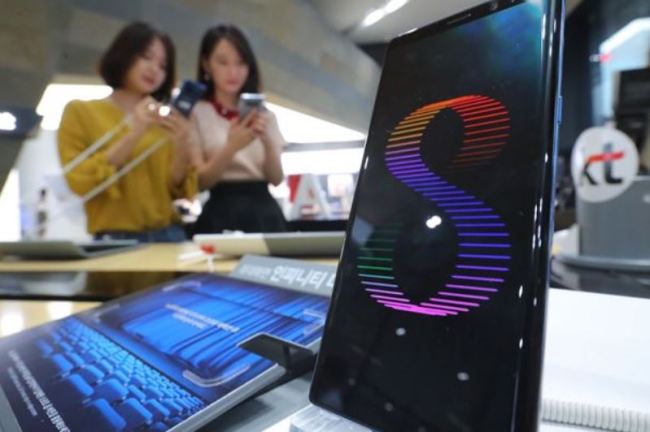[Exclusive] Samsung Galaxy Note 9 to adopt in-display fingerprint scanning: sources
Tech giant reviewing three to four solutions prepared by Samsung Display
By Song Su-hyunPublished : March 22, 2018 - 17:08
Samsung Electronics is likely to adopt in-display fingerprint scanning for its upcoming flagship Galaxy Note 9 smartphones, according to industry sources on Thursday.
“Samsung Display has prepared three or four solutions for Samsung Electronics to embed the fingerprint sensor inside of the main display, and both are seriously considering one of the solutions,” a source told The Korea Herald.
“The delay in deciding on the final concept for the Note 9 is due to the work in adopting the in-display fingerprint sensor,” the source added. “A final decision on adoption of the technology will be made by this month.”
In previous years, the concept for a flagship phone was finalized about five months before its launch.
Industry watchers said they highly expect that the ninth edition of Samsung’s premium Note series will have an in-display fingerprint sensor in order to differentiate it from phones unveiled by Chinese rivals such as Vivo and others that will be launched by Huawei soon.
Samsung Display has been developing technologies for years to commercialize smartphone panels embedded with fingerprint sensors, but they have not reached the parent company’s expectations.
“Samsung Display has prepared three or four solutions for Samsung Electronics to embed the fingerprint sensor inside of the main display, and both are seriously considering one of the solutions,” a source told The Korea Herald.
“The delay in deciding on the final concept for the Note 9 is due to the work in adopting the in-display fingerprint sensor,” the source added. “A final decision on adoption of the technology will be made by this month.”
In previous years, the concept for a flagship phone was finalized about five months before its launch.
Industry watchers said they highly expect that the ninth edition of Samsung’s premium Note series will have an in-display fingerprint sensor in order to differentiate it from phones unveiled by Chinese rivals such as Vivo and others that will be launched by Huawei soon.
Samsung Display has been developing technologies for years to commercialize smartphone panels embedded with fingerprint sensors, but they have not reached the parent company’s expectations.

The panel-making subsidiary of Samsung Electronics is working to improve fingerprint scanning technology on flexible AMOLED panels for the Note 9, another source explained.
“There is enough time for the display company to improve the technology to meet the handset maker’s expectations before the launch of the Note 9 in late August,” he said.
To explain why Samsung is making attempts to fit the fingerprint sensor in the display, an analyst highlighted Samsung’s longtime challenge in placing the fingerprint module.
Samsung changed the location of the fingerprint module on the latest Galaxy S9 series, but kept it on the rear side of the new smartphones. By keeping the fingerprint module on the rear side of the latest Galaxy S9 series smartphones, Samsung couldn’t expand the battery life compared to the previous models.
“The module on the Note 8, which was located horizontally on the left side of the dual camera module on the rear side of the smartphone, was a cause of great inconvenience,” he said.
“The company fixed the problem by placing the fingerprint module below the camera module on the latest S9 series, but having the module on the back reduces space for larger batteries,” he added.
Meanwhile, Samsung Display technologies are being considered for adoption by some Chinese handset makers, according to the sources.
Jusy Hong, director at IHS Markit, said during the Korea Display Spring Conference 2018 this week that fingerprint authentication integrated into smartphone displays will soon be released into the market, most likely by Huawei later this month with the P11 or by Samsung with the Note 9.
In January, Vivo announced it had developed the world’s first phone with a fingerprint scanner built into the display in cooperation with sensor company Synaptics, which has partnered with Samsung Display before.
“While Apple will stick to its 3-D Face ID solution, Samsung and Huawei are expected to adopt the display integrated fingerprint authentication method,” Hong said.
“Considering technological complexity, the in-display scanning technology will cost more than the Face ID technology that is estimated to be $15.2 per unit.”
Samsung sells around 10 million units per year of Note series smartphones, the most expensive models among Samsung phones, and therefore adoption of the in-display fingerprint scanning technology is reasonable, the analyst said, in terms of mass production yields.
“The biggest concern for Samsung Electronics will be low yields of phones with the newest in-display fingerprint sensor,” said an official at a biometrics solution developer.
“A majority of the industry says that technological capabilities to mass produce those phones are still lacking.”
He added, “Samsung would want to launch its premium phones with better fingerprint sensing performance against rivals and higher yields of commercialization.”
Meanwhile, Koh Dong-jin, CEO and head of Samsung’s smartphone business, said last month at a press conference held in Barcelona, “Samsung will not rush to launch foldable or display touch phones being aware of Chinese players.”
“We will release them with more mature technologies when consumers are really in need of those products,” Koh said.
By Song Su-hyun (song@heraldcorp.com)






![[KH Explains] How should Korea adjust its trade defenses against Chinese EVs?](http://res.heraldm.com/phpwas/restmb_idxmake.php?idx=644&simg=/content/image/2024/04/15/20240415050562_0.jpg&u=20240415144419)











![[Today’s K-pop] Stray Kids to return soon: report](http://res.heraldm.com/phpwas/restmb_idxmake.php?idx=642&simg=/content/image/2024/04/16/20240416050713_0.jpg&u=)